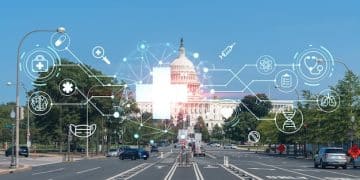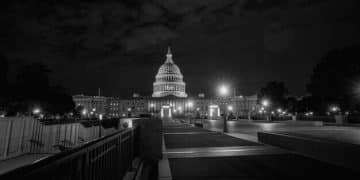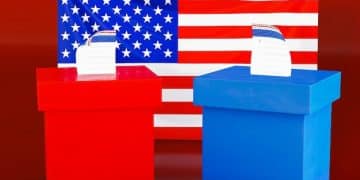Analyzing the Supreme Court’s Impact on US Religious Freedom
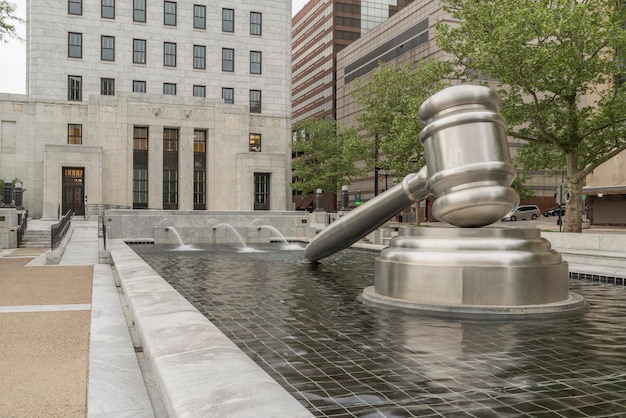
The Supreme Court’s recent decision significantly reshapes religious freedom jurisprudence in the United States, impacting the balance between individual religious exercise and broader societal interests, necessitating a careful examination of its immediate and long-term implications for diverse religious practices and public policy.
Understanding the intricate relationship between legal precedent and individual liberties is crucial, especially when discussing a topic as sensitive and multifaceted as religious freedom. This article delves into the profound implications of the latest Supreme Court decision on religious freedom in the US, exploring its immediate effects and potential future ramifications for American society.
The Evolving Landscape of Religious Freedom Jurisprudence
Religious freedom in the United States, enshrined in the First Amendment, has always been a subject of dynamic interpretation. The Supreme Court plays a pivotal role in defining its boundaries, often reflecting shifts in societal values and legal philosophies. The most recent ruling presents a significant moment in this ongoing evolution, signaling a potential recalibration of the balance between religious exercise and other constitutional concerns.
Historically, the Court has grappled with various tests to determine the permissible scope of government action impacting religious practice. From the “compelling interest” test to the “neutrality and general applicability” standard, each era brought its nuances. This latest decision appears to lean into a particular interpretation, potentially affecting how religious organizations and individuals assert their rights against government regulations.

Historical Context of Supreme Court Rulings
To fully grasp the magnitude of this decision, it is essential to look back at key precedents. Cases like Sherbert v. Verner (1963) and Wisconsin v. Yoder (1972) established robust protections for religious exercise, requiring the government to show a compelling interest and use the least restrictive means when burdening religious practice. However, Employment Division v. Smith (1990) famously diverged, holding that neutral laws of general applicability do not violate the Free Exercise Clause, even if they incidentally burden religion.
- Sherbert Test: Government must show a compelling interest and use the least restrictive means if a law burdens religious exercise.
- Religious Freedom Restoration Act (RFRA): Congress’s response to Smith, aimed at restoring the compelling interest test for federal actions.
- State RFRAs: Many states enacted their versions of RFRA, extending similar protections at the state level.
The tension between these approaches has consistently shaped litigation. Lower courts frequently struggle with applying these standards to contemporary issues, from public health mandates to LGBTQ+ rights. The Supreme Court’s recent intervention thus provides a much-anticipated, albeit contentious, clarification or redirection in this complex legal domain.
This ruling is not an isolated event but rather a piece in a larger mosaic of judicial philosophy regarding fundamental rights. Understanding this broader context helps illuminate the motivations behind the Court’s decision and its potential implications for future cases involving religious liberty. The implications extend far beyond the specific facts of the case, influencing how future legislative bodies frame laws concerning social issues.
The Court’s composition has progressively shifted, leading to a re-evaluation of established precedents. This ideological recalibration is a significant factor in understanding why certain previous interpretations of religious freedom are being revisited. The outcome of recent judicial appointments is now manifesting in tangible legal shifts that have broad societal consequences.
Key Aspects of the Latest Decision
The Supreme Court’s latest ruling concerning religious freedom is highly complex, addressing specific facts while setting potentially far-reaching precedents. It is crucial to dissect the core legal arguments and the Court’s reasoning to understand its immediate impact. The majority opinion, often coupled with concurring and dissenting arguments, provides a comprehensive view of the legal landscape post-decision.
At the heart of the case was a conflict pitting religious exercise against other significant legal or societal interests. The specific issue varied, but the Court’s treatment of it reveals a particular interpretive approach to the First Amendment’s religion clauses. This interpretation could signal a preference for religious accommodations over certain government interests, or perhaps a stricter scrutiny of policies that might inadvertently burden religious practice.
Analysis of the Majority Opinion
The majority opinion, authored by a specific justice, articulated the Court’s judgment. It often focused on the historical understanding of religious freedom, sometimes drawing on founding-era interpretations or natural rights philosophy. The opinion detailed how the specific facts of the case intersected with existing religious freedom jurisprudence, making a case for why their interpretation was the most consistent with constitutional principles.
- Clarity on Standards: The ruling aimed to clarify which legal standard (e.g., compelling interest test vs. neutrality principle) should apply to specific types of religious freedom disputes.
- Scope of Accommodation: It potentially broadened or narrowed the scope under which religious individuals or organizations can seek exemptions from generally applicable laws.
- Distinction between Belief and Practice: The opinion likely reaffirmed the distinction that while belief is absolutely protected, religious practice may be subject to regulation under certain conditions.
The majority emphasized certain aspects of the First Amendment, possibly highlighting the free exercise clause over the establishment clause, or vice-versa. This emphasis is critical because it tells us where the Court sees the primary balance of power lying in these disputes. The way the Court frames this balance will have profound implications for future cases.
Often, majority opinions in significant cases like this also address practical implications, offering guidance to lower courts on how to apply the new or clarified standard. This guidance is vital for ensuring consistency across the federal judiciary. The precision of the language used in the opinion often dictates the breadth of its application.
Dissenting and Concurring Opinions: A Spectrum of Views
Crucial to understanding any Supreme Court decision, particularly one on a contentious issue like religious freedom, are the dissenting and concurring opinions. These opinions provide insights into the legal philosophies and potential paths not taken by the majority. They highlight the complexities and different interpretations of constitutional law, offering a more complete picture of the Court’s reasoning.
Concurring opinions, written by justices who agree with the majority’s conclusion but for different legal reasons, can sometimes be as influential as the majority opinion itself. They might offer alternative justifications or articulate reservations about certain aspects of the majority’s reasoning, potentially shaping future legal arguments. Dissents, on the other hand, lay bare the fundamental disagreements on legal principles and often serve as blueprints for future challenges to the majority’s holding.
Insights from Dissenting Justices
Dissenting justices passionately argued against the majority’s judgment, often predicting negative consequences for civil liberties or societal cohesion. Their arguments typically focused on:
- Potential Erosion of Rights: Concerns that the ruling might weaken protections for other groups or undermine established non-discrimination principles.
- Misinterpretation of Precedent: Arguments that the majority misconstrued or wrongly overturned long-standing Supreme Court precedent.
- Practical Consequences: Warnings about the real-world implications, such as increased litigation or creation of legal loopholes.
The dissenting opinions often emphasize the broader implications for separation of church and state, or the potential for religious exemptions to infringe upon the rights of others. This moral and legal high ground articulated by the dissenters often resonates with legal scholars and concerned citizens alike, keeping the debate alive.
Some dissents become incredibly influential over time, with their arguments eventually forming the basis for future majority opinions that overturn prior precedent. This dynamic underscores the long game characteristic of constitutional law. The arguments presented in dissent are not simply disagreements; they are often deeply considered legal analyses that predict future legal trajectories.
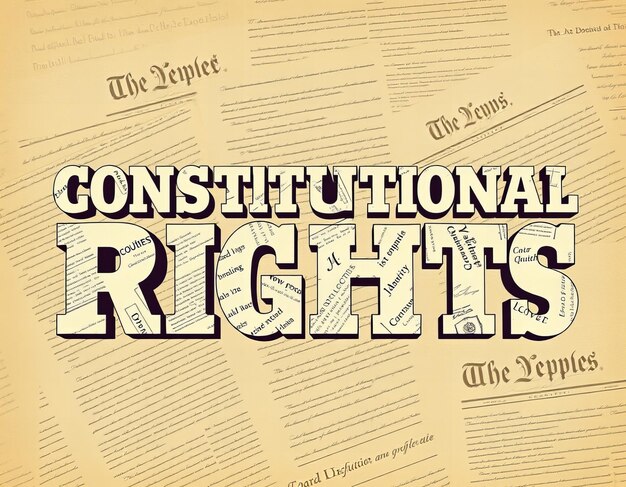
Nuances in Concurring Opinions
Concurring opinions, while agreeing with the outcome, provide additional perspectives. A justice might agree with the result but disagree with the reasoning, offering a narrower or broader interpretation of the majority’s logic. These opinions are vital for understanding the full spectrum of views within the Court that led to the final outcome. Sometimes, a concurrence will provide the crucial fifth vote on a particular interpretation, making it functionally part of the binding precedent.
For example, a concurrence might specifically address concerns about how the ruling applies to different types of religious organizations, or how it interacts with specific state laws. These nuances are important for lower courts trying to apply the ruling to diverse factual scenarios. They can offer crucial caveats or extensions to the main opinion, proving indispensable for legal analysis.
In some instances, a concurring opinion may offer a completely different legal framework that, while reaching the same immediate conclusion, proposes an alternative path for future jurisprudence. This can create uncertainty in the aftermath of a decision, as legal practitioners and scholars debate which reasoning will ultimately prevail in subsequent cases.
Impact on Religious Institutions and Individuals
The Supreme Court’s decision directly affects how religious institutions and individuals navigate their rights and responsibilities within American society. This ruling has the potential to reshape daily practices, policy advocacy, and the broader legal strategies employed by faith-based organizations. Understanding these practical implications is vital for both religious communities and the general public.
For religious institutions, the decision might offer new avenues for asserting their religious liberty in situations where they previously faced legal constraints. This could pertain to hiring practices, service provision, or internal governance. Conversely, it might also create new challenges or require adaptations in how they interact with state and federal regulations, particularly those designed to protect civil rights or public welfare.
Implications for Religious Organizations
Religious organizations, including churches, schools, charities, and service providers, are particularly influenced by shifts in religious freedom jurisprudence. This decision may:
- Expand Exemptions: Potentially grant religious organizations broader exemptions from general laws that conflict with their religious tenets, such as anti-discrimination statutes.
- Affect Funding: Influence eligibility for government funding or contracts, especially if adherence to certain non-religious criteria is seen as burdensome to their faith practices.
- Litigation Trends: Lead to an increase in lawsuits challenging regulations perceived to infringe on religious autonomy, while also potentially increasing defensive litigation for those impacted by such exemptions.
The ruling could empower religious organizations to operate more exclusively based on their doctrines, even when those doctrines conflict with secular laws or public policy. This empowerment could lead to complex situations, particularly in areas like employment, healthcare, and education where religious beliefs intersect with public accommodations and civil liberties.
Moreover, the decision may necessitate a reevaluation of operational policies for religious organizations to ensure compliance with the new legal landscape. This could involve legal reviews of handbooks, service agreements, and internal guidelines to align with the Court’s expanded or clarified understanding of religious liberty. Navigating these changes will require careful legal counsel and strategic planning.
Effects on Individual Religious Freedom
Individuals who hold religious beliefs will also feel the effects of this decision. Their abilities to practice their faith without undue government burden could be either strengthened or challenged. The decision might, for instance, provide greater protection for individuals seeking religious accommodations in the workplace or in public settings.
However, it also raises questions about the scope of individual religious freedom when it potentially impacts the rights or well-being of others. The tension between individual religious exercise and the rights of third parties remains a critical area of concern, and this ruling may either clarify or exacerbate that tension. The balance between these rights is delicate and continually subject to reinterpretation.
Some individuals may find new legal grounds to challenge government mandates or regulations that they believe impose on their faith, while others might find their civic rights diminished by newly granted religious exemptions. The ripple effect could extend into daily life, influencing aspects from what services are available in communities to individual employment opportunities.
Societal Repercussions and Public Policy
Beyond the immediate legal implications, the Supreme Court’s decision on religious freedom carries significant societal repercussions and will undoubtedly influence public policy. The ruling touches upon deeply held beliefs and values, affecting the delicate balance between individual rights, collective well-being, and the role of government in a pluralistic society. It necessitates a close examination of how this judicial pronouncement might shape future legislative debates and community relations.
The decision can stimulate new legislative efforts at both federal and state levels. Lawmakers may be spurred to revise existing statutes or propose new ones to either reinforce or mitigate the effects of the ruling, depending on their political and ideological stances. This legislative activity will reflect ongoing societal debates about the appropriate scope of religious liberty and its intersection with other fundamental rights.
Impact on Anti-Discrimination Laws
One of the most contentious areas affected by religious freedom rulings is anti-discrimination law, particularly concerning LGBTQ+ rights, reproductive rights, and gender equality. The Court’s stance on religious exemptions can:
- Create Tensions: Intensify conflicts between religious freedom claims and non-discrimination principles, potentially leading to situations where religious objections are prioritized over protections for marginalized groups.
- Prompt Legislative Action: Incite legislative bodies to clarify or amend anti-discrimination statutes to address the scope of religious exemptions, possibly leading to more explicit carve-outs or stronger protections.
- Influence Public Services: Affect the provision of public or publicly funded services, such as healthcare, education, or social welfare programs, if religious organizations claim exemptions based on their beliefs.
The ruling could potentially empower individuals or entities to deny services based on religious beliefs, raising concerns about equality and access. This possibility has been a central point of debate in previous religious freedom cases and remains a key area of public concern following this decision. The implications for public sector services are especially profound.
Moreover, the decision might influence how state and local governments enforce their own non-discrimination ordinances. Communities with strong anti-discrimination protections may find themselves in a legal quandary, forced to reconcile local laws with a potentially broader federal interpretation of religious liberty. This complex interplay between state and federal law will require careful legal navigation.
Shaping Future Public Policy Debates
The decision is likely to be a central topic in future public policy debates, influencing discussions on various social issues. Its implications could extend to debates surrounding:
- School Curricula: The content of public school curricula, particularly regarding topics like sex education, history, or science, if religious groups seek greater influence or exemptions.
- Healthcare Access: The types of healthcare services made available by religious providers, including issues such as contraception, abortion, or gender-affirming care.
- Workplace Policies: Workplace requirements related to dress codes, attendance, or conduct if they are viewed as conflicting with an employee’s religious practice.
This ruling sets a specific tone for how religious freedom issues will be approached by policymakers and advocates for years to come. It establishes a new reference point, compelling all parties to adapt their arguments and strategies. The dialogue evolving from this decision will frame much of the future legislative agenda.
Furthermore, the decision may lead to heightened political polarization, as different groups mobilize to support or oppose its perceived implications. The discourse surrounding religious freedom could become even more entrenched in broader culture wars, making compromise and consensus difficult to achieve in policy arenas. This political maneuvering will undoubtedly shape the nation’s legislative landscape.
Comparing with International Religious Freedom Frameworks
Understanding the impact of the Supreme Court’s decision on religious freedom in the US benefits greatly from a comparative perspective. How does the American approach align with or diverge from international religious freedom frameworks and the practices of other democratic nations? This comparison reveals unique aspects of the US legal system and its interpretation of fundamental rights, highlighting both commonalities and distinct divergences.
Many countries grapple with similar questions about the balance between religious freedom and other societal interests, such as public order, health, and anti-discrimination. However, the legal and cultural contexts vary widely, leading to diverse outcomes. Examining these differences helps to contextualize the US approach and assess its broader implications on the global stage.
European vs. US Models of Religious Freedom
European models of religious freedom often differ significantly from the US model. While the US First Amendment adopts an anti-establishmentarian approach and a robust free exercise clause, many European nations have state churches or more direct historical ties between religion and the state. This leads to distinct approaches to religious accommodation and the regulation of religious practice.
- State-Sponsored Religion: Many European countries have official state religions, influencing their approach to religious pluralism.
- Limited Religious Accommodation: European courts often prioritize public order and secularism more strongly, sometimes leading to fewer religious accommodations compared to the US.
- Restrictions on Religious Symbols: Some European nations have laws restricting religious symbols in public spaces, a concept largely challenging in the US.
These distinctions manifest in varied legal outcomes. For instance, debates over the wearing of religious symbols in public schools or the right to provide religiously-based services without adhering to secular standards are handled differently across the Atlantic. The US tends to lean towards greater accommodation, reflecting its unique historical emphasis on individual worship freedom.
The US tradition, shaped by a history of religious dissent and a desire to prevent the kind of religious conflict seen in Europe, has generally fostered an expansive view of religious liberty. However, this also creates unique challenges when religious practices clash with modern secular norms. The current Supreme Court decision potentially reaffirms this uniquely American emphasis, potentially widening the gap with European models.
Global Trends in Religious Liberty
Globally, trends in religious liberty are diverse and often contradictory. Some nations are moving towards greater protection of religious minorities, while others are implementing stricter controls on religious expression. The US decision contributes to this global conversation, influencing how other democracies might perceive and interpret their own commitments to religious freedom.
- Rise of Religious Nationalism: In some countries, religious identity is increasingly tied to national identity, leading to both protection and suppression of religious practices.
- International Human Rights: International human rights instruments, like the Universal Declaration of Human Rights, affirm freedom of thought, conscience, and religion, providing a global baseline.
- Challenges in Diverse Societies: Nations worldwide grapple with managing religious diversity while upholding principles of equality and non-discrimination.
The US, as a leading democracy, holds significant sway in how human rights are perceived and implemented internationally. Its rulings on religious freedom can set precedents or provide arguments for other nations grappling with similar issues, both positively and negatively. The decision can be used by various regimes to justify or critique their current policies.
Therefore, tracking these global trends and comparing them with the US experience offers valuable insights into the universal challenges of protecting religious freedom in increasingly diverse and interconnected societies. It underscores the ongoing nature of this fundamental human right and the varied approaches taken to uphold it amidst diverse cultural and legal landscapes.
Future Legal Landscape and Precedents
The most recent Supreme Court decision on religious freedom is not merely an isolated event; it is a critical juncture that will undoubtedly shape the future legal landscape of the United States. Its implications extend far beyond the immediate case, setting potential precedents that could influence countless future legal challenges and legislative actions. Legal scholars, practitioners, and civil liberties advocates will scrutinize every word of the ruling for clues about the Court’s future trajectory.
The decision might signal a shift in how the Court views the balance between the two religion clauses of the First Amendment—the Establishment Clause, which prohibits government establishment of religion, and the Free Exercise Clause, which protects individuals’ right to practice their religion. A stronger emphasis on one over the other could have profound and wide-ranging effects on American law and society.
Potential for Future Litigation
A significant Supreme Court ruling often serves as a catalyst for new litigation, testing the boundaries and applications of the new legal standard. This decision is likely to inspire:
- Challenges to State Laws: Lawsuits against state and local laws perceived to burden religious practice, testing how lower courts interpret the new standard.
- Cases Involving Public Accommodations: Renewed litigation concerning religious exemptions for businesses or individuals providing services to the public, particularly in areas conflicting with religious beliefs.
- Workplace Religious Accommodations: More cases brought by employees seeking accommodations for their religious practices in various work environments.
The legal community will be actively engaged in interpreting the nuances of the opinion, attempting to predict how it will apply to a myriad of factual scenarios. This often leads to fragmented rulings in lower courts until the Supreme Court provides further clarification through subsequent cases. The precise wording of the majority opinion, along with any concurring or dissenting views, will form the starting point for these intricate legal debates.
Moreover, advocacy groups on all sides of these issues will strategize on how to best utilize or counter the decision. This could involve identifying new test cases, filing amicus curiae briefs, and lobbying legislative bodies for statutory changes that reflect their preferred interpretation of religious freedom. The interplay of judicial, legislative, and social forces will define the extent of the ruling’s impact.
The Doctrine of Stare Decisis
The doctrine of stare decisis, which means “to stand by things decided,” is a fundamental principle in common law systems, encouraging courts to adhere to past precedents. However, the Supreme Court has the power to overturn its own precedents, and this decision raises questions about the stability of existing religious freedom jurisprudence.
If the ruling significantly deviates from or overturns prior landmark decisions, it could signal a more willingness by the current Court to revisit established law, which can create legal uncertainty. The frequency and ease with which the Court engages in such reversals is a critical indicator of its jurisprudential approach.
Conversely, if the decision merely clarifies or incrementally adjusts existing precedent, it might suggest a more measured approach. Regardless, its influence on the interpretative future of cases dealing with church and state separation, individual conscience, and societal norms is undeniable. The long-term effects of this decision on the legal framework for religious freedom will be a subject of intense academic and legal discourse for years to come.
| Key Aspect | Brief Description |
|---|---|
| ⚖️ Jurisprudence Shift | The decision redefines the legal standards for religious freedom cases, impacting the balance between religious exercise and other rights. |
| ⛪ Institutional Impact | Religious organizations may gain broader exemptions from general laws, affecting hiring, services, and public interaction. |
| 🤝 Societal Repercussions | The ruling heightens tensions with anti-discrimination laws and shapes public policy debates on various social issues. |
| 🔮 Future Precedents | Sets a new course for future litigation, influencing how similar cases will be decided and potentially challenging the doctrine of stare decisis. |
Frequently Asked Questions About the Supreme Court’s Religious Freedom Ruling
▼
The main outcome of the recent Supreme Court decision was to clarify or modify the legal standard by which religious freedom claims are assessed. It appears to strengthen protections for religious exercise in certain contexts, potentially making it more difficult for the government to impose burdens on religious practices without meeting a higher legal threshold, thus reshaping the balance established by prior cases.
▼
This decision potentially grants religious organizations broader leeway to operate in accordance with their religious tenets, even when those tenets conflict with generally applicable laws. This could impact areas such as hiring practices, service provision, and exemptions from certain regulations, allowing them more freedom to express their faith through their institutional actions and missions.
▼
The decision could create new tensions with anti-discrimination laws, particularly those protecting LGBTQ+ individuals or ensuring equal access to services. If religious exemptions are expanded, it might allow some religious service providers to assert objections based on faith, raising concerns about potential discrimination and the scope of public accommodations in diverse communities.
▼
Yes, it is highly likely that this ruling will lead to an increase in future litigation. Parties seeking to challenge laws on religious freedom grounds, or those seeking to uphold non-discrimination principles against religious exemptions, will likely rely on this new precedent. This legal uncertainty could necessitate additional guidance from the Supreme Court in subsequent cases.
▼
The US approach to religious freedom, particularly after this decision, may further distinguish it from many international models. While some European nations prioritize secularism or public order, the US might solidify a more expansive view of religious liberty. This could mean greater accommodation for religious practices and institutions, which differs from countries that strictly separate state and faith.
Conclusion
The Supreme Court’s latest ruling on religious freedom is a landmark decision, fundamentally reshaping the legal and social contours of this critical right in the United States. It signals a discernible shift in judicial philosophy, presenting both opportunities for religious exercise and significant challenges for the broader framework of civil liberties and public policy. The careful balance between individual belief and collective societal interests remains a complex and evolving dynamic, with this decision now serving as a prominent point of reference.
As the legal community and the public grapple with its nuances, the full impact will unfold through subsequent litigation, legislative responses, and shifts in societal norms. Understanding the historical context, the intricacies of the decision, and its potential future ramifications is essential for navigating the evolving landscape of religious freedom in America. This ruling is not an endpoint but rather a crucial new chapter in the ongoing dialogue about faith, law, and liberty.

